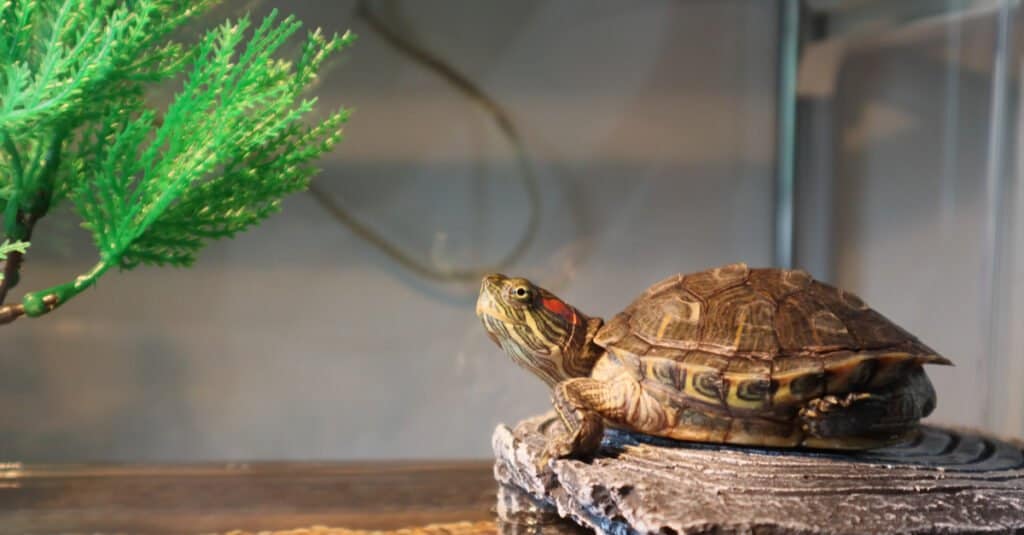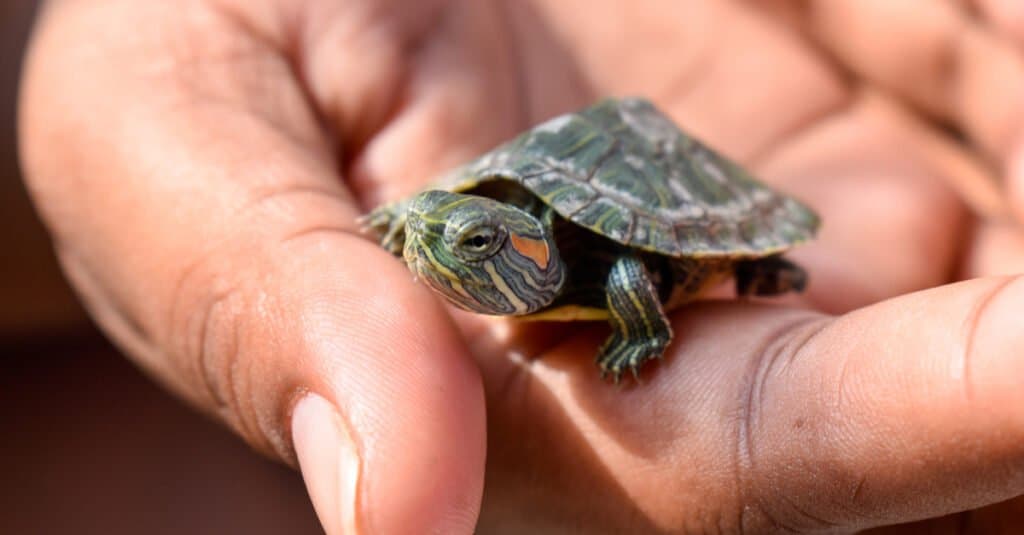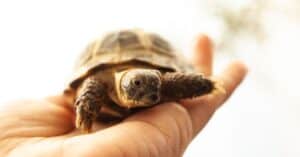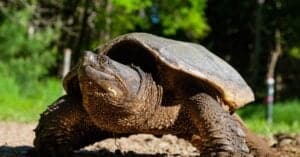Red-Eared Slider: Price and Cost to Own
Red-eared sliders are by far the most popular turtles in the pet trade today. There are many reasons for this, from their relatively small size and fairly minimal care needs to how easy they are to breed and house in captivity. If you’re one of the many reptile enthusiasts looking to adopt your own red-eared slider, you’re no doubt wondering how much they cost to own on average.
Read on to learn more about the average price of a red-eared slider and how much you can expect to spend on adopting one as well as the cost of supplies like an enclosure, food, and lighting.
How Much Do Red-Eared Sliders Cost?

Mark Leung/Shutterstock.com
Red-eared sliders tend to be inexpensive thanks to how large their populations are in the wild and how easy they are to breed in captivity. On average, you can expect to pay anywhere from as little as $15 to $40 for a single turtle. If possible, buy a turtle from a reputable breeder rather than a pet shop. Reptile breeders are more knowledgeable than chain pet shops and generally engage in more ethical breeding practices.
Keep in mind, though, that depending on where you live, the sale of certain turtles like red-eared sliders may be illegal. Some US states, including Oregon, Florida, and Tennessee outright prohibit the sale of them. This is in part due to how invasive this particular species of turtle is and how difficult they are to control as well as the risk they present in spreading Salmonella, especially as babies.
Another important thing to note here is it’s best to hold off on buying a turtle until you’ve purchased and set up a suitable enclosure for them. By setting up your pet’s habitat in advance, you’ll be able to do a “test run” to ensure the lighting, humidity, temperature, and other settings are calibrated correctly. You don’t want to be scrambling to make your new scaly friend comfortable when you don’t even have a proper enclosure setup! Which brings us to…
How Much Do Red-Eared Slider Enclosures Cost?

Akash Naik/Shutterstock.com
For a baby red-eared slider, a 30 to 50-gallon enclosure is suitable until they reach adulthood. When they get to their full size of around 7 to 8 inches, though, they need at least 75 to 100 gallons of space to feel comfortable in captivity.
Most 30 to 50-gallon glass aquarium enclosures cost around $200 to $400. A 75 to 100-gallon enclosure will cost roughly $300 to $500. Custom-built enclosures and starter kits that include supplies will usually cost slightly more than these estimates.
Ideally, your enclosure should be your first purchase if you’re planning on buying a red-eared slider. From there, you’ll be able to set it up with the supplies it needs and ensure all its settings are correct. After the enclosure is fully furnished, you can finally purchase your turtle and place them in their new home.
If you’re able to make the investment, go ahead and purchase a large enclosure rather than a smaller one to start with. Red-eared sliders grow very quickly, and they can live for up to 30 years! Even if it seems like you’ll save money at first by buying a small starter tank, you’ll have to switch this out for a larger one within your turtle’s first year or two of life anyway.
Finally, be sure to purchase an aquarium designed for aquatic and semiaquatic animals instead of a typical terrarium. Aquariums tend to be more durable and are designed to hold more water than terrariums designed for terrestrial animals.
How Much Does Lighting Cost?

iStock.com/:Marina Vedernikova
Now that you hopefully have your enclosure selected, it’s time to start setting it up with the supplies it needs for your turtle to thrive. Heat and UVB are the two main types of light sources the enclosure will need.
When it comes to heat lighting, the air temperature should be somewhere between 85 and 95F and the water temperature between 75 and 85F. The enclosure should also have a small basking spot where the temperature is at least a few degrees warmer. A large, white basking bulb or two is usually enough to heat a 50-to-100-gallon enclosure. Basking bulbs usually cost around $10 to $12 each and can last for several months before burning out.
If temperatures get lower than around 70F at night, you’ll also likely need a ceramic heat emitter or two for when you turn the basking bulb off. A 60 to 100-watt ceramic heat emitter usually costs around $10 to $15 per bulb, and they can last for several weeks or months before they need to be replaced.
UVB lighting is also highly recommended to keep your turtle’s bones and muscles strong. UVB lighting aids in digestion and facilitates healthy, consistent growth. A large bulb with a 5% to 10% output will cost around $15 to $30. UVB bulbs last around 4 to 6 months before they need to be replaced.
All three types of bulbs need fixtures to house them and connect them to the electrical outlets in your home. These are usually either dome-shaped or long and narrow depending on the shape of the bulb you’ve chosen. These fixtures are durable and can last many months or even years before they need to be replaced. Fixtures for bulbs and ceramic heat emitters usually cost around $15 to $30 each.
How Much Do Other Enclosure Supplies Cost?
Aside from the enclosure itself and lighting, there are a few other supplies your slider’s habitat will need. These supplies include:
- Substrate
- A high-quality water filter
- A dual thermometer and hygrometer
- Decorations like rocks, platforms, hides, plants, etc.
Substrate is the material you’ll use to cover the floor of the enclosure. The larger the individual pieces of substrate are, the better, as this will minimize the risk of impaction. A 5LB bag of river rocks or gravel usually costs around $10 to $20.
A durable, high-quality water filter is also essential for keeping the enclosure clean. Water filters can range in price from $30 to $70+ depending on the size of your enclosure. Many are designed to resemble rock formations and waterfalls, which will blend in discreetly with your tank’s existing aesthetic.
Most filters also require cartridges you’ll need to replace every month or two to keep the water clean. These filter cartridges can cost as little as $5 to $10 for packs of three or more.
A dual thermometer and hygrometer will help you monitor the temperature and humidity settings within the enclosure. It’s a good idea to purchase one to monitor the air temperature and humidity and then a water/aquarium thermometer to monitor the water temperature. These are also quite inexpensive, with digital options costing around $5 to $10 each.
Finally, when it comes to decorations, feel free to get creative. You don’t have to create a lot of clutter, as red-eared sliders enjoy exploring open water. A few plants, rocks, platforms, and a hide or two is usually enough. These items range in price from as low as $3 for a small hide or a few rocks to $20 or more for elaborate decorative bridges and platforms.
How Much Does It Cost to Feed a Red-Eared Slider?

iStock.com/slowmotiongli
Once your turtle’s enclosure is set up properly, the cost of food is likely the next factor on your mind. In general, you can expect to pay around $25 to $50 each month on feeding your red-eared slider. These particular turtles are omnivores, so they prefer to eat a mixture of plant matter and small feeder insects. There are also commercial pellet foods you can buy to supplement your turtle’s diet.
As far as plant matter goes, dark, leafy greens should be the main staple food. Collard, dandelion, turnip, and mustard greens are all excellent options. Vegetables like squash, green beans, carrots, and corn are also recommended. Fruit should be kept to a minimum, but occasional pieces of fruits like banana, mango, and apples make great treats.
When it comes to feeder insects and arthropods, crickets, earthworms, shrimp, and mealworms should all be on rotation. Variety is key to ensuring your turtle gets plenty of vitamins and nutrients in their diet.
Other Miscellaneous Costs and Yearly Estimates

iStock.com/фотограф
Finally, we come to other miscellaneous costs and the yearly total estimate associated with caring for a red-eared slider. Some of these costs can include veterinary check-ups, treatments for illnesses or injuries, and potentially paying someone to care for your turtle if you go on vacation or have to travel for work or a family-related emergency.
Unfortunately, it can be difficult to estimate exactly how much you’ll need if your turtle becomes ill or injured or needs care while you’re away. As a rule of thumb, though, you should always keep at least $500 on hand for emergencies.
At this point, we can also estimate approximately how much it costs to care for a red-eared slider per year. The initial setup, including the cost of the turtle itself, its enclosure, and all of its supplies will likely run you somewhere between $600 and $1,000.
However, once your enclosure setup is running smoothly, you can expect to pay around $100 to $300 per year for upkeep costs like replacement lamps, food, and substrate as well as a yearly vet check-up.
More from A-Z Animals
Red-eared sliders are by far the most popular turtles in the pet trade today. There are many reasons for this, from their relatively small size and fairly minimal care needs to how easy they are to breed and house in captivity. If you’re one of the many reptile enthusiasts looking to adopt your own red-eared slider, you’re no doubt wondering how much they cost to own on average.
Read on to learn more about the average price of a red-eared slider and how much you can expect to spend on adopting one as well as the cost of supplies like an enclosure, food, and lighting.
How Much Do Red-Eared Sliders Cost?

Mark Leung/Shutterstock.com
Red-eared sliders tend to be inexpensive thanks to how large their populations are in the wild and how easy they are to breed in captivity. On average, you can expect to pay anywhere from as little as $15 to $40 for a single turtle. If possible, buy a turtle from a reputable breeder rather than a pet shop. Reptile breeders are more knowledgeable than chain pet shops and generally engage in more ethical breeding practices.
Keep in mind, though, that depending on where you live, the sale of certain turtles like red-eared sliders may be illegal. Some US states, including Oregon, Florida, and Tennessee outright prohibit the sale of them. This is in part due to how invasive this particular species of turtle is and how difficult they are to control as well as the risk they present in spreading Salmonella, especially as babies.
Another important thing to note here is it’s best to hold off on buying a turtle until you’ve purchased and set up a suitable enclosure for them. By setting up your pet’s habitat in advance, you’ll be able to do a “test run” to ensure the lighting, humidity, temperature, and other settings are calibrated correctly. You don’t want to be scrambling to make your new scaly friend comfortable when you don’t even have a proper enclosure setup! Which brings us to…
How Much Do Red-Eared Slider Enclosures Cost?

Akash Naik/Shutterstock.com
For a baby red-eared slider, a 30 to 50-gallon enclosure is suitable until they reach adulthood. When they get to their full size of around 7 to 8 inches, though, they need at least 75 to 100 gallons of space to feel comfortable in captivity.
Most 30 to 50-gallon glass aquarium enclosures cost around $200 to $400. A 75 to 100-gallon enclosure will cost roughly $300 to $500. Custom-built enclosures and starter kits that include supplies will usually cost slightly more than these estimates.
Ideally, your enclosure should be your first purchase if you’re planning on buying a red-eared slider. From there, you’ll be able to set it up with the supplies it needs and ensure all its settings are correct. After the enclosure is fully furnished, you can finally purchase your turtle and place them in their new home.
If you’re able to make the investment, go ahead and purchase a large enclosure rather than a smaller one to start with. Red-eared sliders grow very quickly, and they can live for up to 30 years! Even if it seems like you’ll save money at first by buying a small starter tank, you’ll have to switch this out for a larger one within your turtle’s first year or two of life anyway.
Finally, be sure to purchase an aquarium designed for aquatic and semiaquatic animals instead of a typical terrarium. Aquariums tend to be more durable and are designed to hold more water than terrariums designed for terrestrial animals.
How Much Does Lighting Cost?

iStock.com/:Marina Vedernikova
Now that you hopefully have your enclosure selected, it’s time to start setting it up with the supplies it needs for your turtle to thrive. Heat and UVB are the two main types of light sources the enclosure will need.
When it comes to heat lighting, the air temperature should be somewhere between 85 and 95F and the water temperature between 75 and 85F. The enclosure should also have a small basking spot where the temperature is at least a few degrees warmer. A large, white basking bulb or two is usually enough to heat a 50-to-100-gallon enclosure. Basking bulbs usually cost around $10 to $12 each and can last for several months before burning out.
If temperatures get lower than around 70F at night, you’ll also likely need a ceramic heat emitter or two for when you turn the basking bulb off. A 60 to 100-watt ceramic heat emitter usually costs around $10 to $15 per bulb, and they can last for several weeks or months before they need to be replaced.
UVB lighting is also highly recommended to keep your turtle’s bones and muscles strong. UVB lighting aids in digestion and facilitates healthy, consistent growth. A large bulb with a 5% to 10% output will cost around $15 to $30. UVB bulbs last around 4 to 6 months before they need to be replaced.
All three types of bulbs need fixtures to house them and connect them to the electrical outlets in your home. These are usually either dome-shaped or long and narrow depending on the shape of the bulb you’ve chosen. These fixtures are durable and can last many months or even years before they need to be replaced. Fixtures for bulbs and ceramic heat emitters usually cost around $15 to $30 each.
How Much Do Other Enclosure Supplies Cost?
Aside from the enclosure itself and lighting, there are a few other supplies your slider’s habitat will need. These supplies include:
- Substrate
- A high-quality water filter
- A dual thermometer and hygrometer
- Decorations like rocks, platforms, hides, plants, etc.
Substrate is the material you’ll use to cover the floor of the enclosure. The larger the individual pieces of substrate are, the better, as this will minimize the risk of impaction. A 5LB bag of river rocks or gravel usually costs around $10 to $20.
A durable, high-quality water filter is also essential for keeping the enclosure clean. Water filters can range in price from $30 to $70+ depending on the size of your enclosure. Many are designed to resemble rock formations and waterfalls, which will blend in discreetly with your tank’s existing aesthetic.
Most filters also require cartridges you’ll need to replace every month or two to keep the water clean. These filter cartridges can cost as little as $5 to $10 for packs of three or more.
A dual thermometer and hygrometer will help you monitor the temperature and humidity settings within the enclosure. It’s a good idea to purchase one to monitor the air temperature and humidity and then a water/aquarium thermometer to monitor the water temperature. These are also quite inexpensive, with digital options costing around $5 to $10 each.
Finally, when it comes to decorations, feel free to get creative. You don’t have to create a lot of clutter, as red-eared sliders enjoy exploring open water. A few plants, rocks, platforms, and a hide or two is usually enough. These items range in price from as low as $3 for a small hide or a few rocks to $20 or more for elaborate decorative bridges and platforms.
How Much Does It Cost to Feed a Red-Eared Slider?

iStock.com/slowmotiongli
Once your turtle’s enclosure is set up properly, the cost of food is likely the next factor on your mind. In general, you can expect to pay around $25 to $50 each month on feeding your red-eared slider. These particular turtles are omnivores, so they prefer to eat a mixture of plant matter and small feeder insects. There are also commercial pellet foods you can buy to supplement your turtle’s diet.
As far as plant matter goes, dark, leafy greens should be the main staple food. Collard, dandelion, turnip, and mustard greens are all excellent options. Vegetables like squash, green beans, carrots, and corn are also recommended. Fruit should be kept to a minimum, but occasional pieces of fruits like banana, mango, and apples make great treats.
When it comes to feeder insects and arthropods, crickets, earthworms, shrimp, and mealworms should all be on rotation. Variety is key to ensuring your turtle gets plenty of vitamins and nutrients in their diet.
Other Miscellaneous Costs and Yearly Estimates

iStock.com/фотограф
Finally, we come to other miscellaneous costs and the yearly total estimate associated with caring for a red-eared slider. Some of these costs can include veterinary check-ups, treatments for illnesses or injuries, and potentially paying someone to care for your turtle if you go on vacation or have to travel for work or a family-related emergency.
Unfortunately, it can be difficult to estimate exactly how much you’ll need if your turtle becomes ill or injured or needs care while you’re away. As a rule of thumb, though, you should always keep at least $500 on hand for emergencies.
At this point, we can also estimate approximately how much it costs to care for a red-eared slider per year. The initial setup, including the cost of the turtle itself, its enclosure, and all of its supplies will likely run you somewhere between $600 and $1,000.
However, once your enclosure setup is running smoothly, you can expect to pay around $100 to $300 per year for upkeep costs like replacement lamps, food, and substrate as well as a yearly vet check-up.







